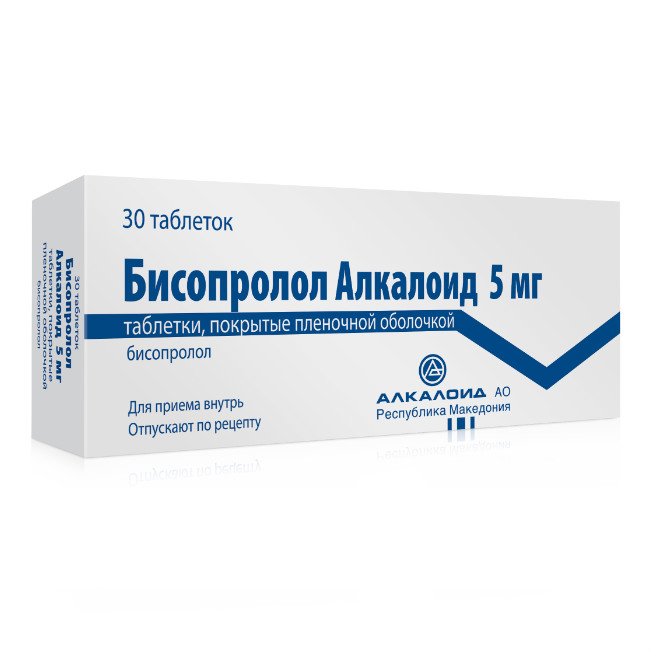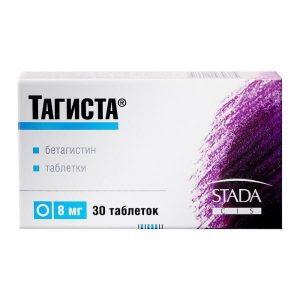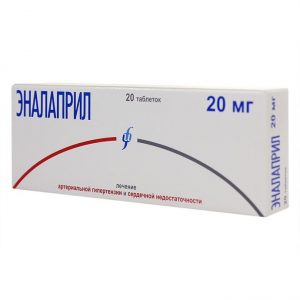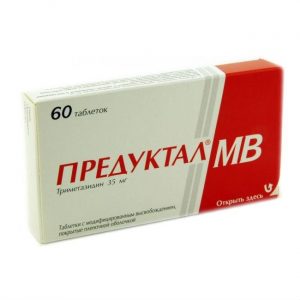Description
Pharmacological action
Pharmacotherapeutic group:
Beta1-blocker selective
ATX:
C.07.AB Selective beta1-blockers
C.07.AB07 Bisoprolol
Selective pharmacodynamic activity – It has a membrane stabilizing effect. Bisoprolol reduces plasma renin activity, reduces myocardial oxygen demand, and reduces heart rate (HR). It has antihypertensive, antiarrhythmic and antianginal effects.
Blocking in low doses beta1-adrenergic receptors of the heart, reduces the formation of cyclic adenosine monophosphate (cAMP) stimulated by catecholamines from adenosine triphosphate (ATP), reduces the intracellular current of calcium ions, inhibits all cardiac functions, and reduces atrioventricular (AV) conductivity and. If the therapeutic dose is exceeded, it has a beta2-blocking effect. The total peripheral vascular resistance at the beginning of the use of the drug, in the first 24 hours, increases (as a result of a reciprocal increase in the activity of alpha-adrenergic receptors and the elimination of stimulation of beta2-adrenergic receptors), after 1-3 days it returns to its original value, and with prolonged use it decreases.
The antihypertensive effect is associated with a decrease in minute blood volume, sympathetic stimulation of peripheral vessels, a decrease in the activity of the sympathoadrenal system (CAS) (of great importance for patients with initial hypersecretion of renin), restoration of sensitivity in response to a decrease in blood pressure (BP) and the effect on the central nervous system the system. With arterial hypertension, the effect develops after 2-5 days, a stable effect is observed after 1-2 months.
The antianginal effect is due to a decrease in myocardial oxygen demand as a result of decreased contractility and other myocardial functions, lengthening of diastole, and improved myocardial perfusion. By increasing the final diastolic pressure in the left ventricle and increasing the stretching of the muscle fibers of the ventricles, oxygen demand may increase, especially in patients with chronic heart failure (CHF).
When used in medium therapeutic doses, unlike non-selective beta-blockers, it has a less pronounced effect on organs containing beta2-adrenergic receptors (pancreas, skeletal muscle, smooth muscles of the peripheral arteries, bronchi and uterus) and does not delay carbohydrate metabolism sodium ions in the body, the severity of the atherogenic effect does not differ from the action of propranolol.
Pharmacokinetics:
Bisoprolol is almost completely (more than 90%) absorbed in the gastrointestinal tract, food intake does not affect absorption. The effect of the primary passage through the liver is negligible (at the level of 10-15%), which leads to high bioavailability (90%). Eating does not affect the bioavailability of bisoprolol.
Bisoprolol is metabolized via the oxidative pathway without subsequent conjugation. All metabolites have a strong polarity and are excreted by the kidneys. The main metabolites found in blood plasma and urine do not show pharmacological activity. The data obtained as a result of experiments with human liver microsomes in vitro show that bisoprolol is metabolized primarily by the CYP3A4 isoenzyme (about 95%), and the CYP2D6 isoenzyme plays only an insignificant role.
Communication with plasma proteins about 30%. Distribution volume – 3,5 l / kg. The total clearance is approximately 15 l / h. The maximum plasma concentration is determined after 2-3 hours. Permeability through the blood-brain barrier and placental barrier is low.
The plasma elimination half-life (10-12 hours) provides efficacy within 24 hours after taking a single daily dose.
Bisoprolol is excreted from the body in two ways, 50% of the dose is metabolized in the liver with the formation of inactive metabolites. About 98% is excreted by the kidneys, of which 50% is excreted unchanged less than 2% – through the intestines (with bile).
Since excretion occurs equally in the kidneys and in the liver, patients with impaired liver function or with renal insufficiency do not need dose adjustment. The pharmacokinetics of bisoprolol is linear and does not depend on age.
In patients with heart failure, plasma concentrations of bisoprolol are higher and the half-life is longer than in healthy volunteers.
There is no information on the pharmacokinetics of bisoprolol in patients with heart failure and concomitant impairment of liver or kidney function.
Indications
Arterial hypertension
coronary heart disease (CHD): prevention of attacks of stable angina pectoris
chronic heart failure (CHF).
Contraindications
Hypersensitivity to bisoprolol, the components of the drug and other beta-blockers, acute heart failure or heart failure in the decompensation stage, metabolic acidosis
pheochromocytoma (without the simultaneous use of alpha-blockers)
simultaneous administration of monoamine oxidase inhibitors (MAOs) (except for type B MAO inhibitors)
up to 18 years of age (efficacy and safety not established)
lactose intolerance, lactose deficiency or syndrome galactose malabsorption.
Precautions: Desensitizing therapy, Prinzmetal angina pectoris, hyperthyroidism, type 1 diabetes mellitus and diabetes mellitus with significant fluctuations in glucose concentration in cropi, AV block I degree, severe renal failure (creatinine clearance (CC) less than 20 ml / min), expressed impaired liver function, psoriasis, restrictive cardiomyopathy, congenital heart defects or heart valve disease with severe hemodynamic disorders, CHF with myocardial infarction over the past 3 months, a strict diet, depression (including a history), old age.
Use during pregnancy and lactation
Bisoprolol has pharmacological effects that can have a harmful effect on the course of pregnancy and / or on the fetus or newborn. Usually beta-blockers reduce placental perfusion, which leads to a slowdown in fetal growth, fetal death, miscarriages or premature births. The fetus and the newborn baby may experience pathological reactions (for example, hypoglycemia, bradycardia, arterial hypotension).
Bisoprolol should not be used during pregnancy, use is possible if if the benefit to the mother exceeds the risk of side effects in the fetus and / or child. In the case when treatment with Bisoprolol is considered necessary, monitoring of the uteroplacental blood flow and fetal development should be monitored. In case of adverse effects on pregnancy or the fetus, alternative therapy should be considered. Symptoms of hypoglycemia and bradycardia usually occur during the first 3 days. You should carefully examine the newborn after childbirth.
There are no data on the release of bisoprolol into breast milk. Therefore, if it is necessary to use the drug during lactation, breastfeeding must be stopped.
Special instructions
Monitoring the condition of patients taking Bisoprolol should include measuring heart rate and blood pressure, conducting an ECG, determining the concentration of blood glucose in patients with diabetes mellitus (once every 4-5 months).
In elderly patients, it is recommended to monitor renal function (1 time in 4-5 months).
The patient should be trained in the method of calculating heart rate and instructed on the need for medical advice for heart rate less than 50 beats / min.
Before starting treatment, it is recommended to study the function of external respiration in patients with a history of bronchopulmonary burden.
Patients using contact lenses should be aware that a decrease in tear fluid production is possible during treatment with the drug.
When using the drug Bisoprolol in patients with pheochromocytoma, there is a risk of developing paradoxical arterial hypertension (unless effective blocking of alpha-adrenergic receptors has been previously achieved).
With thyrotoxicosis, bisoprolol may mask certain clinical signs of thyrotoxicosis (eg, tachycardia). Abrupt withdrawal of the drug in patients with thyrotoxicosis is contraindicated, since it can increase the symptoms.
With diabetes, it can mask tachycardia caused by hypoglycemia. In contrast to non-selective beta-blockers, it practically does not enhance insulin-induced hypoglycemia and does not delay the restoration of blood glucose concentration to normal values.
With the simultaneous use of clonidine, its administration can be stopped only a few days after discontinuation of the drug Bisoprolol.
It is possible to increase the severity of the hypersensitivity reaction and the lack of effect of the usual doses of epinephrine (adrenaline) against the background of a burdened allergic history.
If it is necessary to carry out planned surgical treatment, the drug should be discontinued 48 hours before general anesthesia. If the patient took the drug before surgery, he should choose a drug for general anesthesia with a minimally negative lyotropic effect.
Reciprocal vagus nerve activation can be eliminated by intravenous administration of atropine (1-2 mg).
Medicines that deplete the catecholamine depot (including reserpine), can enhance the effect of running adrenergic blockers, so patients taking such combinations of drugs should be under constant medical supervision to detect a pronounced decrease in blood pressure or bradycardia.
Patients with bronchospastic diseases can be prescribed cardioselective beta-blockers with caution in case of intolerance and / or ineffectiveness of other antihypertensive drugs. With beta-blockers in patients with concomitant bronchial asthma, airway resistance may increase. If the dose of Bisoprolol is exceeded in such patients, there is a risk of developing bronchospasm.
In the case of patients with increasing bradycardia (heart rate less than 60 beats min.), a pronounced decrease in blood pressure (systolic blood pressure less than 100 mm Hg), AV block, it is necessary to reduce the dose or stop treatment.
It is recommended to discontinue therapy with bisoprolol with the development of depression.
Do not abruptly interrupt treatment because of the danger of developing severe arrhythmias and myocardial infarction. Drug withdrawal is carried out gradually, reducing the dose for 2 weeks or more (reduce the dose by 25% in 3-4 days).
The drug should be discontinued before examining the concentration in the blood and urine of catecholamines, normetanephrine, vanillyl mandelic acid, and antinuclear antibody titers.
In smokers, the effectiveness of beta-blockers is lower.
Impact on the ability to drive transp. Wed and fur .:
The use of Bisoprolol does not affect the ability to drive vehicles according to the results of a study in patients with coronary artery disease. However, due to individual reactions, the ability to drive vehicles or work with technically complex mechanisms may be impaired. Particular attention should be paid to this at the beginning of treatment, after changing the dose, as well as while consuming alcohol.
Composition
1 film-coated tablet contains:
active ingredient:
bisoprolol fumarate 5 mg.
excipients:
lactose monohydrate,
microcrystalline cellulose,
silicon dioxide colloidal,
crospovidone,
magnesium stearate.
Dosing and Administration
The drug Bisoprolol is taken orally, in the morning on an empty stomach, once, without chewing, with a small amount of liquid. Tablets should not be chewed or ground into powder.
Treatment of arterial hypertension and angina pectoris
In all cases, the regimen and dosage are selected by the doctor individually for each patient, in particular, taking into account the heart rate and therapeutic response.
In arterial hypertension and coronary heart disease, usually an initial dose of 5 mg once a day. If necessary, increase the dose to 10 mg once a day.
In the treatment of arterial hypertension and angina pectoris, the maximum daily dose is 20 mg 1 time / day. It is possible to divide the daily dose into 2 doses.
Treatment of stable chronic heart failure
The standard treatment regimen for heart failure includes the use of angiotensin converting enzyme (ACE) inhibitors or angiotensin II receptor antagonists (in case of intolerance to ACE inhibitors), beta-blockers, diuretics and, optionally, cardiac glycosides. The beginning of treatment of CHF with the drug Bisoprolol requires a special phase of titration and regular medical supervision.
A prerequisite for treatment with bisoprolol is stable chronic heart failure with no signs of exacerbation.
Treatment of heart failure with Bisoprolol begins in accordance with the following titration scheme. In this case, individual adaptation may be required depending on how well the patient tolerates the prescribed dose, i.e. the dose can be increased only if the previous dose was well tolerated.
To ensure the dosage regimen below, it is possible to use Bisoprolol in the dosage form: 2.5 mg tablets or 5 mg tablets.
Recommended starting dose is 1, 25 mg (1/2 tablet of 2.5 mg) once a day. Depending on individual tolerance, the dose should be gradually increased to 2.5 mg, 3.75 mg (11/2 tablets of 2.5 mg), 7.5 mg (3 tablets of 2.5 mg or 11/2 tablets of Bisoprolol 5 mg) and 10 mg 1 time per day. Each subsequent dose increase should be carried out not less than two weeks later.
If an increase in the dose of the drug is poorly tolerated by the patient, a dose reduction is possible. The maximum recommended dose for heart failure is 10 mg of the drug Bisoprolol 1 time per day.
During titration, regular monitoring of blood pressure, heart rate and the severity of symptoms of heart failure is recommended. The worsening of the symptoms of CHF is possible from the first day of the drug.
If the patient does not tolerate the maximum recommended dose, a gradual dose reduction is possible.
During or after the titration phase, a temporary deterioration in the course of heart failure, arterial hypotension, or bradycardia may occur. In this case, it is recommended, first of all, to carry out dose adjustment of concomitant therapy drugs. It may also be necessary to temporarily reduce the dose of Bisoprolol or to cancel it.
After stabilization of the patient’s condition, a dose titration should be repeated or treatment should be continued.
Special patient groups
Impaired renal or hepatic function: – In cases of impaired hepatic or renal function, mild or moderate degree of dose usually does not require adjustment of
– for severe impaired renal function (CC less than 20 ml / min) and in patients with severe liver disease the daily dose is 10 mg. Increasing the dose in such patients should be carried out with extreme caution.
Currently, there is insufficient data on the use of the drug Bisoprolol in patients with heart failure associated with type 1 diabetes mellitus, severe renal and / or liver dysfunction, restrictive cardiomyopathy, congenital heart defects or heart valve disease with severe hemodynamic disorders. Also, until now, sufficient data have not been obtained regarding patients with heart failure with myocardial infarction over the past 3 months.
Side effects
The frequency of adverse reactions below was determined according to the following (World Health Organization classification): very often – at least 10% often – at least 1%, but less than 10% infrequently – at least 0.1%, but less than 1% rarely – not less than 0.01%, but less than 0.1%: very rarely – less than 0.01%, including individual messages.
From the side of the heart and blood vessels: very often – decreased heart rate (bradycardia, especially in patients with heart failure), palpitations often – a marked decrease in blood pressure (especially in patients with heart failure), manifestation of angiospasm (increased disturbance of peripheral circulation, a feeling of coldness in the extremities (paresthesia) ) infrequently – violation of AV conduction (up to the development of complete transverse blockade and cardiac arrest), arrhythmias, orthostatic hypotension, aggravation of the course of heart failure with the development of peripheral edema (swelling of the ankles, groaning shortness of breath), chest pain.
From the nervous system: often – dizziness, headache, asthenia, increased fatigue, sleep disturbances, depression, anxiety rarely – confusion or short-term memory loss, nightmares, hallucinations, myasthenia gravis, tremors, muscle cramps. Typically, these phenomena are mild and go away, usually within 1-2 weeks after the start of treatment.
On the part of the sensory organs: rarely – visual impairment, decreased lacrimation (should be taken into account when wearing contact lenses), tinnitus, hearing loss, earache very rarely – dry and sore eyes, conjunctivitis, taste disturbances.
From the respiratory system: infrequently – bronchospasm in patients with bronchial asthma or obstructive airways diseases rarely – allergic rhinitis, nasal congestion.
From the digestive system: often – nausea, vomiting, diarrhea, constipation, dry oral mucosa, abdominal pain rarely – hepatitis, increased activity of liver enzymes (alanine aminotransferase, aspartate aminotransferase), increased bilirubin concentration.
From the side of the musculoskeletal system: infrequently – arthralgia, back pain.
From the genitourinary system: very rarely – impaired potency, weakening libido.
Laboratory indicators: rarely – increased concentration of triglycerides in the blood in some cases – thrombocytopenia, agranulocytosis, leukopenia.
Allergic reactions: rarely – skin itching, rash, urticaria.
From the skin: rarely – increased sweating, flushing of the skin, exanthema, psoriasis-like skin reactions very rarely – alopecia, beta-blockers can exacerbate the course of psoriasis.
Other: withdrawal syndrome (increased angina attacks, increased blood pressure).
Drug Interactions
Not recommended combinations
Class I antiarrhythmic drugs (e.g., quinidine, disopyramide, lidocaine, phenytoin flecainide, propafenone), while used with bisoprolol, can reduce AV conduction and contractility of the heart.
Slow calcium channel blockers (BMKCs) such as verapamil and, to a lesser extent, diltiazem, when used simultaneously with bisoprolol, can lead to a decrease in myocardial contractility and impaired AV conduction. In particular, intravenous administration of verapamil to patients taking beta-blockers can lead to severe arterial hypotension and AV block.
Central antihypertensive drugs (such as clonidine, methyldopa, moxonidine, rilmenidine) can lead to a decrease in heart rate and a decrease in cardiac output, as well as to vasodilation due to a decrease in central sympathetic tone. Abrupt withdrawal, especially before the abolition of beta-blockers, may increase the risk of ricochet arterial hypertension.
Combinations requiring caution
Class III antiarrhythmic drugs (eg, amiodarone) may increase impairment of AV conduction.
Topical beta-blockers (for example, eye drops for glaucoma) can enhance the systemic effects of bisoprolol (lowering blood pressure, lowering heart rate).
Parasympathomimetics when used simultaneously with bisoprolol can increase the violation of AV conduction and increase the risk of developing bradycardia.
Concomitant use of bisoprolol with beta-adrenergic agonists (e.g. isoprenaline, dobutamine) can lead to a decrease in the effect of both drugs.
The combination of bisoprolol with adrenergic agonists affecting beta and alpha adrenergic receptors (for example, norepinephrine, epinephrine) can enhance the vasoconstrictor effects of these agents that occur with the participation of alpha adrenergic receptors, leading to an increase in blood pressure. Such interactions are more likely when using non-selective beta-blockers.
Mefloquine when used concomitantly with bisoprolol may increase the risk of developing bradycardia.
Allergens used for immunotherapy, or allergen extracts for skin tests increase the risk of severe systemic allergic reactions or anaphylaxis in patients receiving bisoprolol.
Iodine-containing radiopaque diagnostic agents for intravenous administration increase the risk of anaphylactic reactions.
Phenytoin when administered intravenously, inhalation anesthetics (derivatives of hydrocarbons) increase the severity of cardiodepressive action and the likelihood of lowering blood pressure.
The effectiveness of insulin and hypoglycemic agents for oral administration may vary during treatment with bisoprolol (masks the symptoms of developing hypoglycemia: tachycardia, increased blood pressure).
The clearance of lidocaine and xanthines (except theophylline) may decrease due to a possible increase in their concentration in blood plasma, especially in patients with initially elevated clearance of theophylline under the influence of smoking.
Non-steroidal anti-inflammatory drugs (NSAIDs) (delayed sodium ions and blockade of prostaglandin synthesis by the kidneys), glucocorticosteroids and estrogens (delayed sodium ions) weaken the antihypertensive effect.
Cardiac glycosides, methyldopa, reserpine and guanfacine, slow calcium channel blockers (verapamil, diltiazem), amiodarone and other antiarrhythmic drugs increase the risk of developing or worsening bradycardia, AV block, heart failure and heart failure.
Nifedipine can lead to a significant decrease in blood pressure.
Diuretics, clonidine, sympatholytics, hydralazine and other antihypertensive drugs can lead to an excessive decrease in blood pressure.
The action of non-depolarizing muscle relaxants and the anticoagulant effect of coumarins during treatment with bisoprolol may be prolonged.
Tricyclic and tetracyclic antidepressants, antipsychotics (antipsychotics), ethanol, sedatives and hypnotics increase central nervous system depression.
Concomitant use with MAO inhibitors (with the exception of MAO B inhibitors) is not recommended due to a significant increase in the antihypertensive effect. Simultaneous use can also lead to the development of a hypertensive crisis. The break in treatment between taking MAO inhibitors and bisoprolol should be at least 14 days.
Non-hydrogenated ergot alkaloids increase the risk of peripheral circulation disorders.
Ergotamine increases the risk of developing peripheral circulatory disorders.
Sulfasalazine increases the concentration of bisoprolol in blood plasma.
Rifampicin shortens the half-life of bisoprolol.
Overdose
Symptoms: arrhythmia, ventricular extrasystole, severe bradycardia, AV block, marked decrease in blood pressure, acute heart failure, hypoglycemia, acrocyanosis, difficulty breathing, bronchospasm, dizziness, fainting, convulsions.
Treatment: in case of an overdose, first of all, stop taking the drug, wash the stomach, prescribe adsorbing agents, and conduct symptomatic therapy.
In severe bradycardia, intravenous administration of atropine. If the effect is insufficient, with caution you can enter a tool that has a positive chronotropic effect. Sometimes a temporary setting of an artificial pacemaker may be required.
With a marked decrease in blood pressure – intravenous administration of plasma-replacing solutions and vasopressors.
With hypoglycemia, intravenous administration of dextrose (glucose) may be indicated.
For AV block: Patients should be constantly monitored and treated with beta-adrenergic agonists such as epinephrine. If necessary, staging an artificial pacemaker.
With exacerbation of CHF, intravenous administration of diuretics, drugs with a positive inotropic effect, as well as vasodilators.
In bronchospasm – the appointment of bronchodilators, including beta2-adrenergic agonists and / or aminophylline.
Storage conditions
Store in a dry, dark place at a temperature not exceeding 25 ° C.
Keep out of the reach and sight of children.
Expiration
2 years.
active substance
bisoprolol
from
pharmacies Prescription
Prescribing
For prescribing by the doctor
Indications
Indications
heart failure, hypertension, arrhythmia




